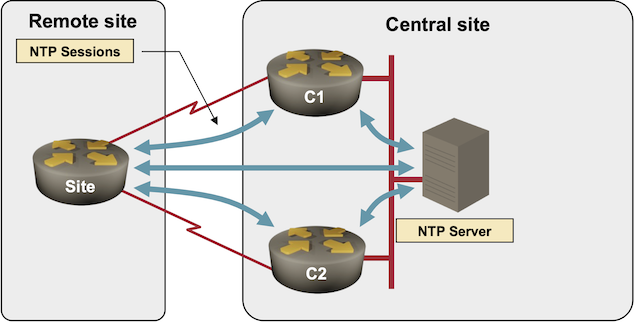SNTP Configuration
Articles » Network Time Protocol (NTP) In a Nutshell » SNTP Configuration
The SNTP configuration in Cisco IOS is (as one would expect) much simpler than the NTP configuration:
- You can configure the SNTP-related logging with the sntp logging configuration command;
- Upstream NTP server is configured with the sntp server ip-address configuration command. You can configure multiple servers for redundancy purposes.
The SNTP process will not synchronize to the configured SNTP servers if you’ve previously entered any NTP-related configuration commands on the router (ntp logging is enough), as the NTP process in Cisco IOS receives replies that should be received by the SNTP process (remember: NTP and SNTP use the same UDP port number). The only way to fix this problem is to reload the router.
Configuration Example
We’ll configure SNTP on the WAN edge router (S1) used on a non-redundant small site small-site:

Simple remote site using SNTP synchronization
The configuration commands are as simple as they can get:
sntp logging
sntp server C1
sntp server C2
sntp server NTP-Server
The SNTP process should quickly acquire the correct time from the NTP servers and generate syslog messages as it synchronizes with the servers (see the following listing). Multiple synchronizations might occur if the SNTP process reaches a high-stratum NTP server before a low-stratum one.
00:00:56: %SYS-6-CLOCKUPDATE: System clock has been updated from 14:09:51 UTC Mon Feb 25 2008 to 13:29:59 UTC Mon Feb 25 2008, configured from SNTP by 10.0.0.5.
00:01:59: %SYS-6-CLOCKUPDATE: System clock has been updated from 13:31:02 UTC Mon Feb 25 2008 to 13:31:02 UTC Mon Feb 25 2008, configured from SNTP by 10.0.0.10
The show sntp command can be used to display the current synchronization status:
Site#show sntp
SNTP server Stratum Version Last Receive
10.0.0.5 7 1 00:00:56
10.0.0.10 6 1 00:01:03 Synced
10.0.0.6 7 1 00:00:15
